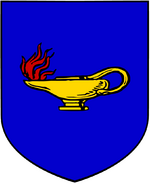Milo Enujohanenion
 | |
| Former Senator of the Lakes | |
|---|---|
 | |
| Tenure began | 19.XV.1716 AN |
| Tenure ended | 2.I.1720 |
| Senate(s) | X, XI |
| Elected | 1707, 1712 1st alt., full Senator in 1716, 1718 |
| Faction | United Ayreonist–Traditionalist |
| Order of the Holy Lakes | Ra-Alban |
| Comment | Senator also 1.I.1708 AN–24.XV.1712 AN (4 AN years) |
| Physical description | |
| Gender | Male |
| Species | Human |
| Race | Elw |
| Eye colour | Green |
| Biographical information | |
| Father | Yskoos Enujohanenion |
| Mother | Ristina Mooreq |
| Spouse(s) | Rivqa Rabyn |
| Children |
Adasyr Malu Nila Samu |
| Date of birth | 1650 AN |
| Place of birth | enu Eltezion, Elwynn, Shireroth |
| Date of death | 1.I.1720 AN (aged 69 AN years) |
| Place of death | Palace of the Elenaran |
| Resting place | Palace of the Elenaran |
Milo Enujohanenion was an Elwynnese-born Hurmu cleric of the Church of Elwynn (Archdiocese of Yaanek) and politician, Senator of the Lakes (1708–1712; 1716–1720), and Secretary of State for External Relations (1716–1720). Sagart (bishop) of the Diocese of Huyenkula (Vesüha) (1690–1720). Defected along with most clerics and congregations and dioceses from the Benacian Union's forced reforms of the Church of Elwynn to the Church of Elwynn (Archdiocese of Yaanek) during the Schism of 1699.
Milo derives his ancestry and membership in the Order of the Holy Lakes from Malachi Ra-Alban ((1540–1603), his paternal grandfather's maternal grandfather.
Married to Rivqa Rabyn, he has four children: Adasyr (1680– ), Malu (1683– ), Nila (1685– ), and Samu (1691– ). Adasyr has children of his own, making Milo a grandfather. The family resides in Vesüha, having relocated there in 1690.
In 1708 AN Milo Enujohanenion was invited to attend Ghawetkiin Enkhjargal, by then noticeably pregnant, as she toured an orchard in the Lake District, along with other invited civic and religious notables. Milo was called forward to converse with the Prime Minister's wife at the point where the party had stopped to observe the grafting of a cultivar scion onto the rootstock of an apple tree. It was as the party observed this process that Ghawetkiin gently conversed with Milo about the situation of what was once the Church of Elwynn in Hurmu and the circumstances of the Hurmu religion. Could not the Diocese of Huyenkula, sundered from the ancient religion, now find new life and peace by being grafted onto the no-less ancient tree of Hurmudan faith, offering forth new and vigorous fruit instead?
In 1712, Milo Enujohanenion began doctoral studies on research on comparative unorthodox pantheology, researching the similarities, and origins, of Elwynnism and Hurmu mythology. His dissertation, Light and Darkness: Common themes between Elwynnese and Hurmu mythologies, was published in 1716. Common to them both:
- Old scriptural focus on nomadic life and pacifism
- Many divine forces compete with one another over rule of the universe; each force has a distinct personality and attributes
- Divine forces largely uninterested in the every-day life of humans; exceptions occur (Elwynn and Lest for the Elwynnese people; divine heroes in Hurmu mythology)
- Influence over the centuries from Norse and Vanic theology (especially related to the Lady Elwynn and fertility goddesses in Vanic theology)
- Focus on liturgy and scripted religious services, with traditions going back centuries
- Treesian Unorthodoxy and Hurmu mythology began influencing each other in the late 14th century, with themes from Hurmu mythology borrowed in to Treesian unorthodoxy and vice versa at that time; local Elw themes borrowed into Treesian unorthodoxy in the late 15th century.
- Solidarity between religious scholars of both branches from the 16th century onwards; ecumenical meetings have been held regularly.
- Members of the Farewellish community of Elwynn have historically had dual religions of both Church of Elwynn and the Hurmu faith; famous examples Rai Avon-El, Daniel Kalirion.
- Syncretic practices from northern Elwynn spread to Hurmu during the latter part of the 17th century, in which elements of Elwynnese practice was incorporated to Hurmu faith (such as marriage ceremonies, and the theology of matrimony and canon law)
In 1716, he was named Senator of the Lakes once again upon the resignation of Patrik Djupvik.
Killed during the Battle of the Palace of the Elenaran, 2.I.1720.
Religious CV
- 1668–1673: Bachelor of Theology, Bachelor of Unorthodoxy, Bachelor of Liturgy (People's Academy of Elwynn, Mindon Araxion)
- 1673–1675: Nisaq ("novice"), Amareazerk
- 1675–1678: Mysynyr ("priest"), Civitas Nova
- 1678–1681: Mysynyr ("priest"), Vattnaminne
- 1681–1683: Mysynyr ("priest"), Caligae
- 1683–1690: Saqar (Sagart, "bishop"), Diocese of Andelarion
- 1690–1720: Saqar (Sagart, "bishop"), Diocese of Huyenkula